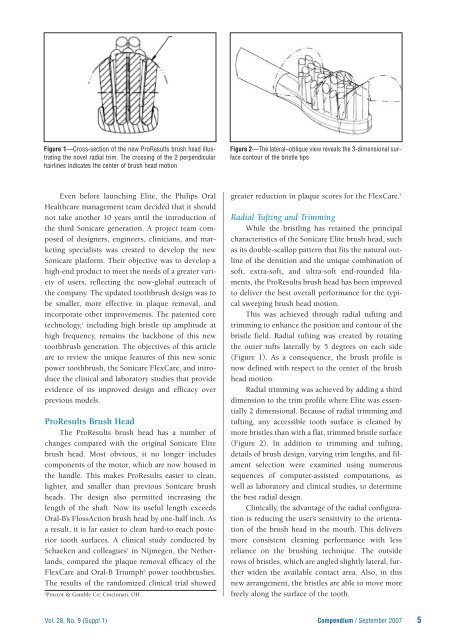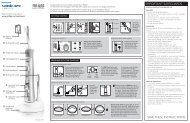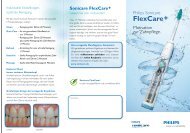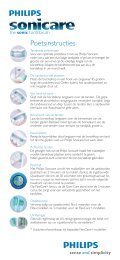Philips Sonicare FlexCare - Sonicare.com - Sonicare
Philips Sonicare FlexCare - Sonicare.com - Sonicare
Philips Sonicare FlexCare - Sonicare.com - Sonicare
You also want an ePaper? Increase the reach of your titles
YUMPU automatically turns print PDFs into web optimized ePapers that Google loves.
Figure 1—Cross-section of the new ProResults brush head illustrating<br />
the novel radial trim. The crossing of the 2 perpendicular<br />
hairlines indicates the center of brush head motion<br />
Figure 2—The lateral–oblique view reveals the 3-dimensional surface<br />
contour of the bristle tips<br />
Even before launching Elite, the <strong>Philips</strong> Oral<br />
Healthcare management team decided that it should<br />
not take another 10 years until the introduction of<br />
the third <strong>Sonicare</strong> generation. A project team <strong>com</strong>posed<br />
of designers, engineers, clinicians, and marketing<br />
specialists was created to develop the new<br />
<strong>Sonicare</strong> platform. Their objective was to develop a<br />
high-end product to meet the needs of a greater variety<br />
of users, reflecting the now-global outreach of<br />
the <strong>com</strong>pany. The updated toothbrush design was to<br />
be smaller, more effective in plaque removal, and<br />
incorporate other improvements. The patented core<br />
technology, 1 including high bristle tip amplitude at<br />
high frequency, remains the backbone of this new<br />
toothbrush generation. The objectives of this article<br />
are to review the unique features of this new sonic<br />
power toothbrush, the <strong>Sonicare</strong> <strong>FlexCare</strong>, and introduce<br />
the clinical and laboratory studies that provide<br />
evidence of its improved design and efficacy over<br />
previous models.<br />
ProResults Brush Head<br />
The ProResults brush head has a number of<br />
changes <strong>com</strong>pared with the original <strong>Sonicare</strong> Elite<br />
brush head. Most obvious, it no longer includes<br />
<strong>com</strong>ponents of the motor, which are now housed in<br />
the handle. This makes ProResults easier to clean,<br />
lighter, and smaller than previous <strong>Sonicare</strong> brush<br />
heads. The design also permitted increasing the<br />
length of the shaft. Now its useful length exceeds<br />
Oral-B’s FlossAction brush head by one-half inch. As<br />
a result, it is far easier to clean hard-to-reach posterior<br />
tooth surfaces. A clinical study conducted by<br />
Schaeken and colleagues 7 in Nijmegen, the Netherlands,<br />
<strong>com</strong>pared the plaque removal efficacy of the<br />
<strong>FlexCare</strong> and Oral-B Triumph b power toothbrushes.<br />
The results of the randomized clinical trial showed<br />
b<br />
Proctor & Gamble Co; Cincinnati, OH.<br />
greater reduction in plaque scores for the <strong>FlexCare</strong>. 7<br />
Radial Tufting and Trimming<br />
While the bristling has retained the principal<br />
characteristics of the <strong>Sonicare</strong> Elite brush head, such<br />
as its double-scallop pattern that fits the natural outline<br />
of the dentition and the unique <strong>com</strong>bination of<br />
soft, extra-soft, and ultra-soft end-rounded filaments,<br />
the ProResults brush head has been improved<br />
to deliver the best overall performance for the typical<br />
sweeping brush head motion.<br />
This was achieved through radial tufting and<br />
trimming to enhance the position and contour of the<br />
bristle field. Radial tufting was created by rotating<br />
the outer tufts laterally by 5 degrees on each side<br />
(Figure 1). As a consequence, the brush profile is<br />
now defined with respect to the center of the brush<br />
head motion.<br />
Radial trimming was achieved by adding a third<br />
dimension to the trim profile where Elite was essentially<br />
2 dimensional. Because of radial trimming and<br />
tufting, any accessible tooth surface is cleaned by<br />
more bristles than with a flat, trimmed bristle surface<br />
(Figure 2). In addition to trimming and tufting,<br />
details of brush design, varying trim lengths, and filament<br />
selection were examined using numerous<br />
sequences of <strong>com</strong>puter-assisted <strong>com</strong>putations, as<br />
well as laboratory and clinical studies, to determine<br />
the best radial design.<br />
Clinically, the advantage of the radial configuration<br />
is reducing the user’s sensitivity to the orientation<br />
of the brush head in the mouth. This delivers<br />
more consistent cleaning performance with less<br />
reliance on the brushing technique. The outside<br />
rows of bristles, which are angled slightly lateral, further<br />
widen the available contact area. Also, in this<br />
new arrangement, the bristles are able to move more<br />
freely along the surface of the tooth.<br />
Vol. 28, No. 9 (Suppl 1) Compendium / September 2007<br />
5










